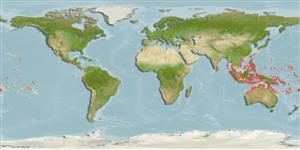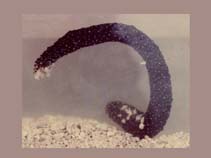Holothuria coluber Semper, 1868
Snake fish| Native range | All suitable habitat | Point map | Year 2050 |

|
| This map was computer-generated and has not yet been reviewed. |
| Holothuria coluber AquaMaps Data sources: GBIF OBIS |
Classification / Names Common names | Synonyms | CoL | ITIS | WoRMS
Holothuroidea | Holothuriida | Holothuriidae
Environment: milieu / climate zone / depth range / distribution range Ecology
Reef-associated; depth range 0 - 25 m (Ref. 81020), usually 0 - 8 m (Ref. 92930). Tropical
Distribution Countries | FAO areas | Ecosystems | Occurrences | Introductions
Pacific ocean, excluding Hawaii.
Length at first maturity / Size / Weight / Age
Maturity: Lm ? range ? - ? cm Max length : 60.0 cm TL male/unsexed; (Ref. 122); common length : 40.0 cm TL male/unsexed; (Ref. 122); max. published weight: 1.0 kg (Ref. 122)
Short description Morphology
Mean live weight 300 to 1000 g; body-wall thickness 0.4 cm. Body cylindrical, very elongate, larger near the posterior end. Tegument very tough. Papillae on bivium short; emerging from warts; podia on trivium conical, stout, yellow, arranged in 10 rows on the radii and interradii; calcareous disc of podia around 400 micrometer in diameter. Mouth ventral, surrounded by 20 very long, stout tentacles of characteristic yellow color; mouth also surrounded by a collar of small papillae. Anus surrounded by 5 groups of 3 small papillae. Calcareous ring with large and high radial pieces and narrow interradials. Cuvierian tubules absent. Black, with yellow podia. Spicules on tegument with tables and pseudo-buttons; tables with circular discs showing 8 holes, bearing a spire of 4 pillars, with spiny crown, hollow in the middle; pseudo-buttons plate-like with denticulate border; rods in the podia and papillae smooth, with holes at their ends; tentacles with nodulous rods.
Not known to be traditionally harvested, but in recent times, due to increasing demand, this species also appears in the processed products of some Pacific Islands; low commercial value. Collected by hand while wading on the reefs at low tide, or by divers. Found in moderately shallow water; mostly on inner reef flats of fringing and lagoon-islet reefs and shallow coastal lagoons; abundant on sandy-muddy grounds with rubble or coral patches, where it hides the posterior part of its body (Ref. 122). Inhabits the edges of reefs and under boulders. Feeds on the surface of sediments (Ref. 92930). Population densities between 0.1 and 0.2 per square meter (Ref. 122).
Life cycle and mating behavior Maturity | Reproduction | Spawning | Eggs | Fecundity | Larvae
Main reference
References | Coordinator | Collaborators
Conand, C. 1998. (Ref. 122)
IUCN Red List Status (Ref. 130435)
Least Concern (LC) ; Date assessed: 18 May 2010
CITES status (Ref. 108899)
Not Evaluated
CMS (Ref. 116361)
Not Evaluated
Threat to humans
Harmless
Human uses
Fisheries: minor commercial
| FishSource |
Tools
More information
Internet sources
BHL | BOLD Systems | CISTI | DiscoverLife | FAO(Publication : search) | Fishipedia | GenBank (genome, nucleotide) | GloBI | Gomexsi | Google Books | Google Scholar | Google | PubMed | Tree of Life | Wikipedia (Go, Search) | Zoological Record
Estimates based on models
Preferred temperature
(Ref. 115969): 25.5 - 29.3, mean 28.6 (based on 2638 cells).
Price category
(Ref. 80766):
Unknown.



